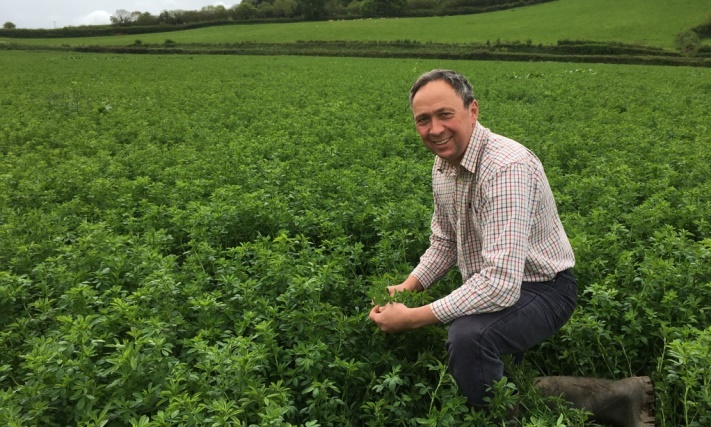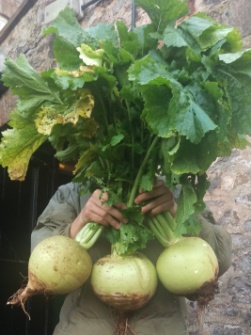Somerset farmer relies on a variety of forage crops
Forage crops play an important part at Briddicott Farm in Somerset.
Andrew Speed farms 448 hectares (1100 acres) of tricky, red sandstone land on north facing slopes facing the Bristol Channel. He has rented the farm from the Crown Estates for the past 12 years.
He grows 204 hectares (500 acres) of cereals and there are also 1,000 Poll Dorset cross Friesland ewes and lambs and a 45-cow suckler herd.
Andrew has developed his sheep dairy over the past 20 years, starting with pure Polled Dorset ewes, gradually coming to the Friesland cross to produce out of season lambers that are prolific, produce high quality milk and good meat lambs.
“We do our sheep a little differently from other milk producers,” Andrew explains. “We lamb in three tight periods, at the end of November, the end of February and mid May, for a total of ten and a half weeks each year. We rear all the lambs on their mothers for five to six weeks, giving them the greatest start in life.

“Lambs born in November spend the first two weeks indoors and then have three to four weeks on pasture before weaning and finishing off indoors on creep feed. February-born lambs are weaned and finished outside on grass with some creep offered. Lambs born in May finish just off grazed grass.
“Many other producers treat their sheep like dairy cows, taking the lambs straight away and artificially rearing them. But we put an equal emphasis on milk and meat production.
“Our lambs go mainly to Dunbia deadweight and kill out at 18.3kg, grading 40% E, U and 59% R for conformation. To my mind, lamb is an important part of the enterprise, and we need to make the most of them by treating them as a legitimate output.”
Most of the milk is sold to local farmer David Baker at Styles Farm, who processes it into chocolate, vanilla, strawberry or blueberry ice cream. He sells it at West Country shows and festivals, including Glastonbury.
The milk sells for between £1 and £1.20/litre, which at an average yield of 200 litres/ewe – can return £2,900 per hectare, at a stocking rate of 14.5 ewes/ha.
The ewes and lambs are housed and fed a complete diet mixed and delivered by forage wagon in winter, consisting of lucerne and maize silage, soya and home-grown rolled barley, oats or peas.
Sheep love lucerne
Andrew restarted growing Lucerne five years ago after a 20-year gap, and says the sheep prefer it to any other silage.
Grown on eight hectares (20 acres), the lucerne fields are taken out of the four-year arable rotation and left in for five to six years. They build fertility by fixing nitrogen from the air and aid soil structure by creating vertical drainage channels.
The Luzelle lucerne is drilled in early to mid summer, into soil that has been limed to bring the pH up to 7, deep sub-soiled to break up any compaction and spread with farmyard manure.
Grass weed control is carried out in January and 80-100kg/ha of potash applied each spring.
The crop is mown, leaving stubble of 10cm (4 inches) at early budding stage. In 2015 this occurred on 23 May, but this year it was cut later on 4 June. Left for one day to wilt, the crop is just rowed up – not tedded, to conserve the leaf portion, and picked up by forage harvester. The first three cuts are placed into a clamp; the final cut is baled. Yields over 13t dry matter/ha are common.
Andrew adds maize silage as a starch source in the feed for the ewes, and in previous years has grown his own crops. But with fields not entirely suited to growing maize, he decided to sow a pea/barley/vetch mixture on 4ha (10 acres) at the beginning of April last year. A dose of 200Kg/ha of triple super phosphate (TSP) was added to the seedbed, but no other inputs were applied.
“This is our learning crop,” says Andrew. “We have tried it out on the advice of Tony Walkers from Oliver Seeds, who feels it will be much better suited to our later ground. It is ready to harvest 12 to 14 weeks after sowing, which means we won’t get caught out harvesting maize in late October. There will be plenty of time to drill winter wheat, even after cultivations and creating a sterile seed bed.”
The leguminous vetch mixture was ensiled in the clamp and fed out as part of the complete diet to the ewes, and to weaned calves that are housed from November.
The suckler cows are outwintered on Winter Feed, a mixture of autumn and winter brassicas including kale, forage rape and Green Globe turnip.
 Drilled in early July and given 300kg/ha of compound fertiliser, this crop is strip grazed behind an electric fence.
Drilled in early July and given 300kg/ha of compound fertiliser, this crop is strip grazed behind an electric fence.
The cows also have access to strategically placed round bales of pea haulm, which are placed unwrapped in the field when the pea crop is harvested. They eat the one opened that day and lie on the remains of previous days bales. This reduces any potential soil damage from taking tractors in for daily feeding during winter.
The cows are taken indoors at the end of January and calve in a seven-week block from 25 February, which keeps management of similar aged calves simple. The Winter Feed is ploughed in before spring oats or peas are drilled.
The calves have been sold until now as 12-14 month stores, but from 2017 will be taken through as finishing cattle.
As well as 115ha (280 acres) of permanent pastures, mainly on the steep-sided slopes, which rise to 320m (1,000ft), which are used for grazing, Andrew also grows short-term grass leys within the arable rotation.
He currently sows Javelin, a medium-term dual-purpose mixture of early, intermediate and late perennial ryegrasses, with timothy and white clover, after winter barley has been harvested.
It is grazed by milking ewes for the rest of the year, and by ewes and lambs in spring. In mid April it receives 300Kg/ha of compound fertiliser, and shut up for a hay cut in mid to late June.
This hay is made into small and large bales and sold mainly to the horse market.
“This is another example of a versatile mixture that really suits our system,” comments Andrew. “It is early enough to get the ewes and lambs out onto straight after lambing, is good for growing young cattle, and also has the persistence to give us good yields of high quality hay.”
With so many enterprises and customers to manage, and also hosting numerous school and group visits, Andrew’s days are always full.
“Yes there’s always such a lot going on,” admits Andrew. “But I love it and wouldn’t have it any other way!”
This is an edited version of an article that appeared in Farmers Guardian on 1 July 2017
